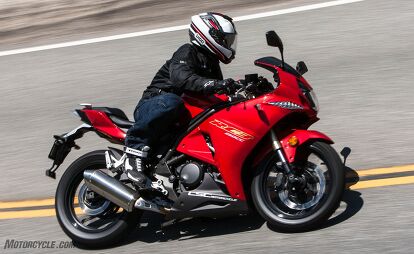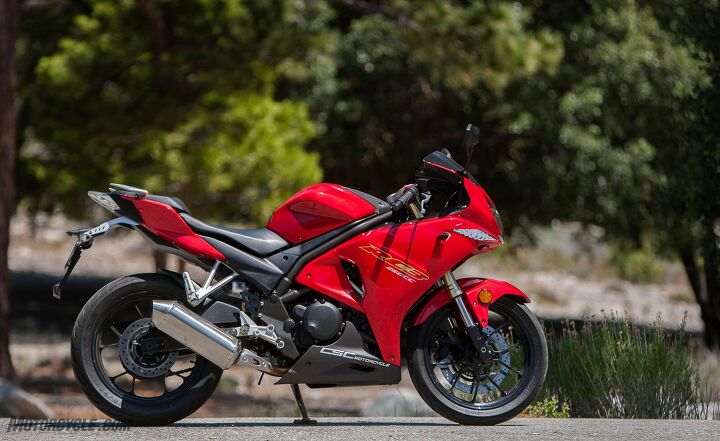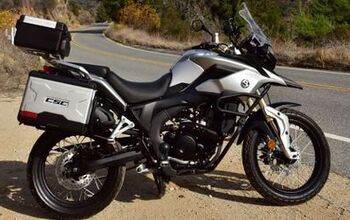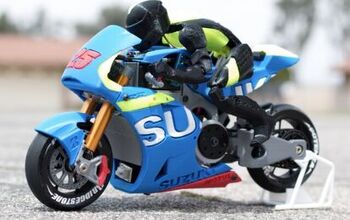2016 CSC RC3 Review

Changing how we think about Chinese motorcycles.
What do you think of when you hear “Chinese motorcycle?” Cheap, ugly, and under-performing? Those observations would be largely correct, as the majority of Chinese motorcycles to come to these shores (that’s the United States, for our international readers) were exactly that. Let’s face it: the words “Made In China” aren’t held in high regard.
2016 CSC RC3
| Engine | 12.0/20 |
| Suspension/Handling | 7.5/15 |
| Transmission/Clutch | 5.0/10 |
| Brakes | 7.5/10 |
| Instruments/Controls | 4.0/5 |
| Ergonomics/Comfort | 6.5/10 |
| Appearance/Quality | 8.0/10 |
| Desirability | 5.0/10 |
| Value | 9.0/10 |
| Overall Score | 64.5/100 |
But maybe we shouldn’t be so quick to judge. CSC is looking to change how we think about Chinese motorcycles. Its first attempt (outside its line of Mustang mini cruisers) was the RX3 250cc adventure bike, which impressed the hard-to-please Tom Roderick in this review. Now with the RC3, a sportbike built on the same bones, CSC is looking to impress a different group of riders.
The RC3 is powered by the same Zongshen 250cc, liquid-cooled, fuel-injected, SOHC, 4-valve Single as the RX3, spitting out a respectable 19.6 hp and 13.7 lb-ft of torque when spun on the MotoGP Werks dyno. Bore and stroke measure 77mm x 53.6mm with 11.5:1 compression. For comparison, the closest competitor to the CSC, Honda’s erstwhile CBR250R, with its liquid-cooled, fuel-injected 249cc Single, made 22.5 hp and 15.2 lb-ft to the wheel during our 2013 Beginner Bike Shootout. The Honda’s bore and stroke measure 76.0mm x 55.0mm, and though it runs a lower 10.7:1 compression ratio, the little CBR has the benefit of two overhead cams to the CSC’s one. Of course, that’s moot now since the CBR250R has been superseded by the CBR300R.
From a fit and finish standpoint, the RC3 doesn’t fit the stereotype we’ve given to Chinese motorcycles. Styling looks clean and distinguished for a sporty bike, and all the body panels line up as they should without any gaps or glaring fitment issues. No errant wires could be found, either. Basically, the RC3 is shucking the mold of Chinese motorcycles being cheap afterthoughts. “Big kudos for a Chinese-built bike that looks twice as fabulous as its price tag would indicate,” says E-i-C Duke.
The RC3 rolls on 17-inch wheels (110/70-17 front, 140/70-17 rear), features a single floating disc with two-piston caliper up front ABS), steel-braided lines, gold-anodized inverted fork with rebound adjustment, preload- and rebound-adjustable shock, a digital dash display, gear indicator, LED turn signals and brake light, a massive 5.28-gallon fuel tank, and both 12v and 5v power outlets on the top triple tree plucked straight from the RX3. Oddly, the RC3 features ABS only on the front, from Continental judging by the sticker on the gauge cluster. Duke surmises front-only ABS is a way to “cheaply bring ABS to the low-rung Asian areas, this bike’s primary market.”
All this for an initial price of $2895, part of CSC’s Don’t Miss The Boat program which rewards those who purchase a motorcycle from CSC’s initial shipment with a discounted price. Once all the models from the first shipment have been sold, pricing for the RC3 goes up to the standard price of $3495 – significantly cheaper than the $4399 Honda’s asking for the current CBR300R, if price is your biggest priority.
But How Does It Ride?
So far, the RC3 impresses with the three F’s: Fit, Finish, and Features. Riding the bike is pleasant, but this wouldn’t be a review of a Chinese motorcycle if it didn’t have a few quirks.
Firstly, it should be noted that the RC3 CSC gave us to review was a pre-production unit, most obvious by its speedo, odo, and trip meters all reading in kilometers rather than miles. Right away, throwing a leg over the RC3 reveals a motorcycle that feels compact, but still roomy enough for my 5-foot, 8-inch frame. My guess is riders who aren’t much taller than me would feel cramped. Seat height is 30.25 inches, and reaching the ground is easy enough.
The bike feels easy to toss between your legs despite its 370-lb wet weight. This compared to the 357 lbs the CBR250R weighs when similarly fuelled. Then again, when you consider the CSC is carrying nearly two gallons more fuel than the Honda’s 3.4 gallons, the weight difference is easy to forgive.
Duke says the clutch engages softly and feels a little weak, and yes, you’ve gotta feather the clutch slightly and give a steady amount of throttle to launch. It won’t win many stoplight-to-stoplight drag races, but the power feels adequate considering its displacement. Rowing through the gears is a mandate when you’ve only got 20 horses to play with, and while we applaud the fact it has a six-speed trans, it does feel notchy at times in both directions, requiring a firm flick to engage. Neutral is also hard to find, especially at a stop. Hopefully this is a condition that fades away with more kilometers on the clock.
That said, the RC3 will reach and maintain freeway speeds, but you’ll have to plan ahead when trying to pass another vehicle, as passing power isn’t readily available above 70 mph. With its small dimensions and relatively light weight, crosswinds can blow the RC3 and its rider about. Duke noticed “Some awfully crude harmonic moans from the airbox,” while I was paying more attention to the pleasantly throaty pitch from the exhaust. Vibes from the Thumper make the hands start to tingle after 30 minutes or so of sustained freeway riding.
Without a doubt, though, the RC3’s most controversial aspect is its handling. The RC3 steers very quickly, seemingly falling into turns at the mere thought of direction change. Normally, that’s a good thing when talking about sporty motorcycles, but less so in the RC3’s case.
“It steers with unpredictability,” says Duke, continuing, “Its front wheel feels like a caster more than any bike I’ve ever ridden.” Both Evans and John Burns agree, noting that the RC3’s quick steering and “completely numb front end,” to quote Brasfield, make the RC3 a very odd-handling motorcycle. Kevin also noted, “I wouldn’t be surprised to find out there was less than 80mm of trail.”
And, in fact, Kevin is right. Trail is a critical number when it comes to a motorcycle’s handling – too little and it’s unpredictable, too much and the bike steers slow. The RC3 features some radical geometry numbers: 22º rake, 75mm trail, and a wheelbase of 52.4 inches. How extreme are these numbers? Here are a few of the RC3’s contemporaries for comparison:
| Rake | Trail | Wheelbase | |
| CSC RC3 | 22.0º | 75mm | 52.4 in. |
| Honda CBR250R | 25.0º | 98.6mm | 53.9 in. |
| Kawasaki Ninja 300 | 27.0º | 94.0mm | 55.3 in. |
| Yamaha R3 | 25.0º | 94.0mm | 54.3 in. |
| Yamaha R6 | 24.0º | 96.5mm | 54.1 in. |
To find a motorcycle that comes anywhere near matching the geometry numbers of the RC3, we turn to Buell. A favorite of our own John Burns, the XB9 “always felt super stable,” he says despite its 21º rake and short 52.0-inch wheelbase. Its trail, however, measures 83mm. Just enough to provide a solid front-end feel.
My opinions about the RC3’s handling seem to differ from the others in the MO crew. When I first hopped on the bike, I too was startled by its quick, almost twitchy, steering, but once I got used to its characteristics I learned I could turn much later into a corner while moving my weight further towards the front to get some feel. Of course with 20 horses it struggles to haul butt up our favorite mountain roads, but on the way down I could keep up with riders on bigger bikes using this late turn-in technique. And if I did need to scrub speed quickly, the front brake lever is nice and firm, thanks to the braided lines, “even if power is merely adequate,” says Duke. Is it the perfect handling machine? Far from it, but learn its nuances and it can be a fun ride.
Is CSC The Real Deal?
If you ask me, I think CSC and the RC3 are a very viable alternative to small-displacement Japanese bikes. My fellow MOrons might disagree with me because of the funky handling, but if price is your primary concern, then the RC3 is a good platform to learn the basics of riding on the cheap before moving up to something bigger and better.
Then again, the CSC customer has to be a very specific person. Namely one who likes to get their hands dirty. CSC sells direct to customers. As Tom mentioned in his RX3 review, for its low entry price the CSC customer has to be willing to accept a few trade-offs with the CSC experience compared to buying a Japanese or European motorcycle.
CSC offers to fully or partially build your motorcycle and then ship it directly to your door (or you can pick it up if you’re local). A full service manual is included with each purchase, and CSC is working on producing online tutorials for basic, intermediate, and advanced repairs or maintenance work.
Each CSC comes with a two-year warranty on parts and a one-year warranty on service. Strangely, should a warranty issue arise, CSC will send the parts and will allow (in fact, CSC encourages…) customers to work on the bike themselves to solve the issue. And if you don’t trust your own wrenching abilities, CSC will contract with a local shop to do the work. Unorthodox to say the least, but CSC representatives have so far stated they’ve had no issues with this process.
If you’re cool with those stipulations, and don’t want to blend in with all the other Kawasakis and Hondas on the road, the RC3 might be worth a look.
+ Highs
- Attractive price
- Attractive styling
- Fit and Finish far better than other Chinese bikes we’ve seen.
– Sighs
- Uninspiring handling (at least to the other MOrons)
- Clunky gearbox
- Especially outclassed now that the Japanese have moved to 300s
2016 CSC RC3 Specifications | |
|---|---|
| MSRP | $3,495 |
| Horsepower | 19.6 @ 7800 rpm |
| Torque | 13.7 lb-ft @ 6000 rpm |
| Engine Capacity | 249.7cc |
| Engine Type | Liquid-cooled, 4-stroke, single overhead cam, 4-valve single-cylinder with balance shaft |
| Bore x Stroke | 77mm x 53.6mm |
| Compression | 11.5:1 |
| Fuel System | Delphi EFI |
| Transmission | 6-speed |
| Final Drive | Chain |
| Frame | Steel |
| Front Suspension | Rebound adjustable inverted fork |
| Rear Suspension | Preload and rebound adjustable monoshock |
| Front Brake | Four-piston caliper, 300mm single disc |
| Rear Brake | Twin-piston caliper, 240mm single disc |
| Front Tire | 110/70-17 |
| Rear Tire | 140/70-17 |
| Seat Height | 30.3 inches |
| Wheelbase | 52.4 inches |
| Rake/Trail | 22°/2.95 inches |
| Curb Weight | 370 lbs |
| Fuel Capacity | 5.28 gal |
| Colors | Blue, White, Red |
| Warranty | 2 years unlimited mileage. The first year is parts and labor, the second year is parts only. |

Troy's been riding motorcycles and writing about them since 2006, getting his start at Rider Magazine. From there, he moved to Sport Rider Magazine before finally landing at Motorcycle.com in 2011. A lifelong gearhead who didn't fully immerse himself in motorcycles until his teenage years, Troy's interests have always been in technology, performance, and going fast. Naturally, racing was the perfect avenue to combine all three. Troy has been racing nearly as long as he's been riding and has competed at the AMA national level. He's also won multiple club races throughout the country, culminating in a Utah Sport Bike Association championship in 2011. He has been invited as a guest instructor for the Yamaha Champions Riding School, and when he's not out riding, he's either wrenching on bikes or watching MotoGP.
More by Troy Siahaan

















































Comments
Join the conversation
The Chinese can't manufacture the little balls in a ballpoint pen. I'm going to trust them with my motorcycle? No thanks.
I keep hearing how they're going to surpass us, build this and that better and cheaper, be the new world economic superpower, yadda yadda yadda. Heard the same thing about Japan throughout the '80s. How'd that work out?
(Of course, we've spent the last eight years imitating the worst policies of both these countries, so I suppose they could catch up that way.)
Until these Chinese manufacturers get a dealership network in place to provide support and service, they will go nowhere.